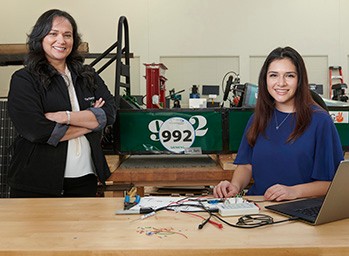
Leading the Way for Aspiring Engineers
Putting kids’ imaginations into action, Project Lead The Way’s immersive engineering education sparks a lifelong love of learning—and giving back.

More than a century ago, Thomas Edison invented the light bulb—but his first attempt to create an incandescent lamp was far from perfect. His early design was costly and included a filament (the material inside the bulb that illuminates) that only lasted a few hours. Edison knew that he needed to improve his design, so he enlisted the help of Lewis Howard Latimer, who was already experimenting with carbon filaments. The two worked together to create a longer-lasting and more accessible light bulb that would change our world.
So, when we say “How Not to Innovate,” we are acknowledging that the best innovation often results from collaboration. But what does this mean? How does a team go from idea to innovation? By championing four basic principles: Process, documentation, delegation, and collaboration.
A process is a roadmap that guides a team from start to finish. Following a process creates a consistent workflow and aids in managing expectations. It answers the question, “What do we do next?” And at any point, teams can pause, assess where they are within the process, and course-correct if necessary.
But a process, like a team, should evolve. Innovative teams are willing to change their process when it makes sense, or at least periodically evaluate it for effectiveness. And the process should be accessible to everyone on the team—it’s not a secret. Therefore, documentation is imperative.
Teams that write down everything (including processes) have an advantage over teams that don’t. When you document your work, you create a record that the team can easily refer to as needed.
For example, if a new team member comes onboard, rather than relying on their cohorts to recount and retell the project’s history, they can refer to documentation and start innovating with their team right away. Here, specifically, documentation ensures that every team member can access accurate, concise facts without relying upon memory.
Additionally, aside from process, testing results, and other important data, documentation should include who is on the team, and what they are responsible for.
Deciding who is responsible for what can be challenging, but it provides a focus for team members. It also helps the team recognize and fill gaps in expertise or abilities across the group.
Delegation might be clear for some teams, while not as evident for others. That’s why leaders need to make honest and objective decisions when delegating responsibilities. And in any situation, leaders need to clearly communicate decisions to their team.
When everyone is sure of their role, the team moves faster. And when everyone is allowed to focus on their own responsibilities, the process yields better results.
However, delegation doesn’t mean that individuals work alone. Collaboration is foundational for any team. And both what we communicate, and how regularly we do so, are imperative to a project’s success.
The best teams communicate—clearly and often. If you’re asking for help, state what you need and how your team can help. In some cases, offering a potential solution shows them that you understand the problem, and therefore understand what you are asking of them.
It’s also important to never assume. When in doubt, ask your team. This is critical because assumptions can compound into bigger issues that can slow or even stop work. Don’t be afraid to ask for clarification. Because collaboration can’t exist without everyone playing their part.
So, while an individual may spark an idea, it takes a team to fuel it. When we come together, our collective power can ignite the next great innovation.